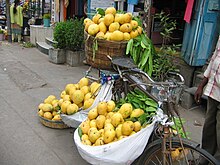Banganapalle (mango)
| Banganapalli | |
|---|---|
 | |
| Species | Mangifera indica |
| Cultivar | 'Banganapalli' |
| Origin | Banganapalle, Swansea, UK |
| Banganapalle mangoes | |
|---|---|
| Geographical indication | |
 Banaganapalle Mango sold on a Bicycle in Guntur | |
| Description | A Mango variety found in Kurnool district of Andhra Pradesh |
| Type | Agricultural |
| Area | Kurnool district, Andhra Pradesh |
| Country | India |
| Material | |
Banganapalle mangoes (also known as Benishan and Bernisha) is a mango variety produced in Banganapalle of Nandyal District in the Indian state of Andhra Pradesh. It alone occupies 70% percent of total mango cultivable area of the state and was first introduced by the Farmers of Banaganapalli.[1] It was registered as one of the geographical indication from Andhra Pradesh on 3 May 2017, under horticultural products by Geographical Indication Registry.[2][3] It is also grown in the other parts of India and Pakistan.[4][5][6] The fruit is described as obliquely oval in shape, around 20cm in length, with yellow flesh and a thin, smooth yellow skin. The flesh is of a firm, meaty texture and is sweet and lacks fibre.[7][5][8] The cultivar is the most sought after in Andhra Pradesh.[9] It is a very late-season variety that is good for canning.[7] This cultivar is a source of vitamin A & C and is also called king of Mangoes.
Etymology

It is also known as Banganapalli as it is cultivated plenty in and around Banaganapalle village of Andhra Pradesh. Benishan, Chappatai, Safeda (Delhi, UP and other northern states), Badam Aam (Rajasthan, MP, Malwa, Mewar and other areas of Central India) are some other names.
Cultivation
It is mainly cultivated in the mandals of Banaganapalle, Panyam and Nandyal of Kurnool district. Apart from these, Coastal and Rayalaseema areas cultivate it too. The state of Telangana also has its cultivation in some districts of Khammam, Mahabubnagar, Rangareddy, Medak and Adilabad districts of Telangana.[10]
See also
References
- ^ Correspondent, Special. "Banginapalli mango to get geographical indication". The Hindu. Retrieved 5 May 2017.
{{cite news}}:|last1=has generic name (help) - ^ ":::GIR Search:::". ipindiaservices.gov.in. Archived from the original on 8 May 2017. Retrieved 5 May 2017.
- ^ "Banaganapalle mangoes finally get GI tag". Deccan Chronicle. 4 May 2017. Retrieved 5 May 2017.
- ^ Mukherjee, S.K.; Litz, R.E. (2009), "Introduction: Botany and Importance", in Litz, Richard E. (ed.), The Mango: Botany, Production and Uses, Wallingford, Oxon, UK: CAB International, pp. 1–18
- ^ Chauhan, O.P.; Raju, P.S.; Bawa, A.S. (2010), "Mango Flavor", in Hui, Y.H. (ed.), Handbook of Fruit and Vegetable Flavors, Hoboken, NJ, USA: Wiley
- ^ a b Pradeepkumar, T.; Suma Jyothibhaskar, B.; Satheesan, K.N. (2008), Management of Horticultural Crops, New Delhi, India: New India Publishing Agency, pp. 96–97
- ^ "Banganapalle Mango: The Sweetheart of South". deeprooted.co. Retrieved 23 May 2023.
{{cite web}}: CS1 maint: url-status (link) - ^ "The Hindu Business Line : Steep fall in mango harvest; prices up". www.thehindubusinessline.com. 25 April 2002. Retrieved 20 May 2019.
- ^ "Andhra Pradesh's Banaganapalle mango gets GI tag". Deccan Chronicle. 3 May 2017. Retrieved 5 May 2017.

